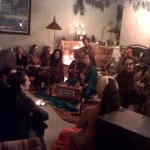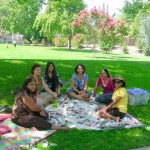: Raising Kids in the Noise of Non-Violence
By Sri Sri Ravi Shankar
Sri Sri Ravi Shankar is a spiritual teacher and the founder of the Art of Living Foundation, an international nonprofit educational, humanitarian and service organization with centers in over 140 countries. Sri Sri Ravi Shankar travels throughout the world teaching the art of living.
Sri Sri Ravi Shankar gave an extemporaneous talk on youth violence recently at Harvard University. The following article is composed of excerpts from that talk:
If we just take a look at the children, the way they were in schools a few decades back, and then take a look at the children today, we see some marked differences. These may provide some insight into the violence among children today.
Pride in Violence
There is no sense of shame or guilt involved with crime today. Instead, a sense of pride is attached to acts of violence. A few decades back, violence was associated not so much with pride, but with shame. A student used to feel ashamed to do a violent act. But today, due largely to the influence of the media, aggression has become a source of pride. The aggressive students in the classroom get more attention, and they feel proud being aggressive and angry.
When I was a student, if someone was aggressive in the classroom, others would look down on them. That student would feel very apologetic afterwards, and they would have to make it up—by being kinder and doing service in the classroom. But today, we see that aggression seems to be a way of living, a way of moving forward, a way of success, and a source of pride in children. This, in a very subtle way, encourages violence. When aggression and violence are promoted in society, human values diminish.
Today, certain movies and modern music glorify frustration, anger and revenge, and make these status symbols and role models for children. We need to counteract this influence. A sense of shame has to be connected with anger and violence. We need to promote human values, especially love, compassion and a sense of belonging, loud and clear.
Dealing with Emotions
Basically in the teenage years, from about 15 to 20, there is considerable emotional turmoil and turbulence happening within. If teenagers do not find a way to express these emotions, they are stuck with them. These emotions ferment and become violence.
Neither at school nor at home have we taught our kids how to handle their own emotions. Any amount of counseling, talking, or reading books does not help because it is all working at an intellectual level. When emotions arise, they come like a storm; they overtake us—our intellect, our concepts, our ideas. So what to do?
We can compare emotions with the owner of a house, and the intellect or concepts with the gatekeeper. The gatekeeper will stop someone from coming from outside, but if the owner of the house comes in and goes out, the gatekeeper cannot do anything about it, because the gatekeeper is being paid by the owner! So our emotions are like the owner. And the intellectual concepts, the ideas, the promises that we make to ourselves—these do not help at all.
Counseling is dealing with the gatekeeper or the watchman. It is not really dealing with the owner of the house, who is in control. Emotions are more in control of our life than our intellect, our thoughts, our concepts and ideas.
The Importance of the Breath
So how do you tackle the emotions? It has to be done at the existential level, at the level from where they arise. Here, I would say the breath could play an important role. Have you noticed that every emotion has a definite pattern of breath? Suppose you are in the acting field. If you want to show anger, the director would ask you to breathe a certain way. If you breathe faster, then you are able to exhibit that anger. In the same way, there is definite rhythmic pattern of breath associated with every emotion. Joy, frustration, sadness, jealousy, and greed all have definite rhythmic breathing patterns. When we attend to these definite breath patterns, we can gain control over our breath as well as our emotions. Just as in the acting field we can use the breath to show our emotions, in the same way, we can utilize the breath to calm down the emotions.
Certain breathing techniques can be learned that are powerful tools in which every cell of our body becomes energized, and impressions of aggression get released, impressions which have infiltrated the cells of our body. By nature one feels calm and serene afterwards.
A Sense of Belonging
The second thing is lack of a sense of belonging. We have developed a program for the children called ART Excel (All Round Training for Excellence). In this program, I ask the child to make one new friend every day. Let’s say there are 30 to 40 children in a classroom, a child is not friendly with all 30 to 40 kids. Each class has ten groups of three children each. But if a child is unable to be friendly with 30 people over a period of one, two or three years, how are they going to be friendly when they get out of school? We have not taught children the basic values of life: how to be friendly with everybody, how to have a sense of belonging with everyone. So one of the things we teach in the ART Excel program is to make one new friend every day.
Standing in Someone Else’s Shoes
A third thing is to have a child step out of her shoes and get into someone else’s shoes, and see from there. See the other person’s point of view. Here also I give another exercise to the children. Suppose they say they hate someone very much. I would tell them, “Okay, behave like those whom you hate for just 15 minutes, half an hour, or half a day.” They suddenly realize the person whom they hate is loveable too. Do you see what I am saying? Despite the shortcomings of that person, the child is able to like them.
Increasing Self-Esteem
A deep sense of regret and low self-esteem is another cause of aggression. Telling a child continually, “You are no good”—all the time bombarded with this thought: “You are no good”—makes a child lose their self-esteem and become more aggressive. We need to bring up their self-esteem. This is the fourth aspect. For this also, we have several processes that make children feel good about themselves.
Smiling Through Criticism
The fifth aspect is to see that nothing can take away your self-respect. Suppose someone makes a comment about you. You should have the ability to withstand that criticism and smile through it. Most children do not have the strength to withstand criticism. A child should have the ability to criticize boldly and then to withstand any criticism that is given to them, in whatever manner. This opens them up to such a strength within themselves that they are able to move through any ragging or teasing they may happen to encounter.
A Sense of Humor
A sense of humor is very important, and helps children handle teasing. Inculcate a sense of humor in children, so they develop the ability to turn an adverse situation to their advantage by bringing humor into it. A sense of humor helps children withstand criticism and enables them to give criticism in a more playful manner. You will often find that those children who do not have a sense of humor are more aggressive.
Physical Activity
Those children who do not engage in some physical activity are also more aggressive. We need to attend to their exercise. A child who is weak becomes more aggressive. You will not find a child who does a lot of exercise, who goes to the gymnasium, who swims, who has a strong healthy body, being too agitated or angry. Often children who play video games or sit, with very little physical activity, are more prone to violence than those who do a lot of physical activity. So we should take care that a child does enough exercise.
Food
Another aspect is children’s food habits. When they eat too much sugar or drink too many carbonated drinks, they become restless and aggressive. There have been several studies done on this subject. But you can experiment yourself: have more sugar and see how you feel. Your attention gets distracted. Many children have Attention Deficiency Disorder. This is also because of wrong food habits.
Drinking too many soft drinks adversely affects our system and makes us more aggressive. You see, by nature our system is made to breathe out carbon dioxide. But we are pumping carbon dioxide into water and drinking it as soft drinks. So we are doing something against nature.
When a person feels aggressive, he breathes faster. Have you noticed? An aggressive person doesn’t breathe slowly; he breathes faster because the system needs more oxygen. In the process of breathing everything tenses, and that comes out as aggression. This can also happen to someone if they are given a lot of carbon dioxide in the form of soft drinks. So healthy food habits also play a role in causing a person to become less violent.
The Noise of Non-Violence
We need to attend to all these eight factors in order to promote non-violence among young people today. Parents and educators need to place greater emphasis on human values, including compassion, service to society and an understanding of how precious all life is.
Often violence comes with noise. Non-violence happens in silence. People who are violent make a huge noise; they make it known. People who are non-violent are quiet. But the time has come for people who are nonviolent to make noise so that the violence will quiet down. The message of non-violence has to come loud and clear so that it can be heard from a young age.
The ART Excel program (All Round Training for Excellence) for children and teens between the ages of 8-18 is through the Art of Living Foundation. ART Excel (All Round Training in Excellence) is a dynamic program for youth that enables them to eliminate stress, handle emotions, deal with peer pressure, and develop leadership skills. Youth are provided techniques that increase mental focus and facilitate the learning process. The ART Excel curriculum nurtures human values and embraces all cultures, religions, ethnic and racial backgrounds. Kids have fun, as they become creative and responsible leaders of tomorrow.
For more information about the ART Excel program, please contact:
Gungun Kapoor @ 510-456-5121
www.tinyurl.com/KidExcel


